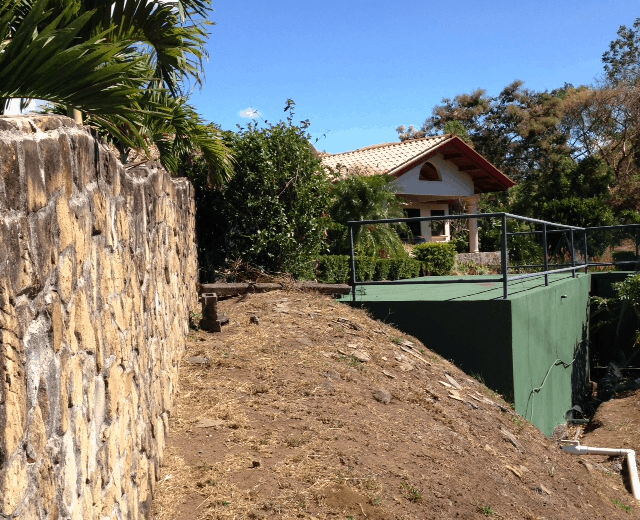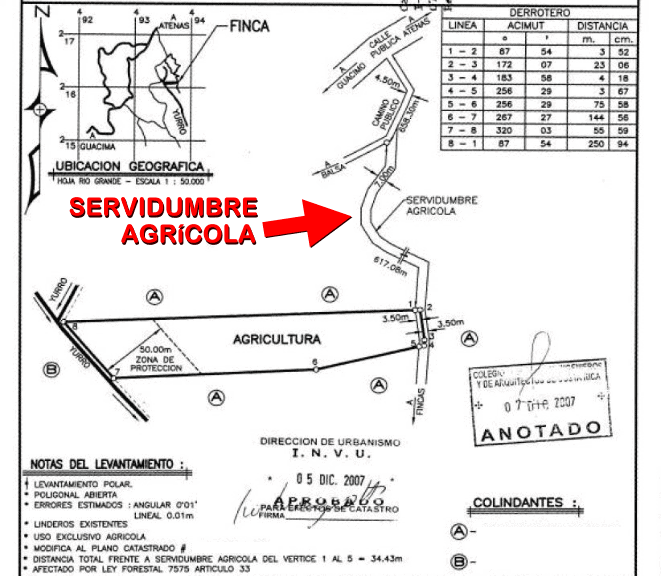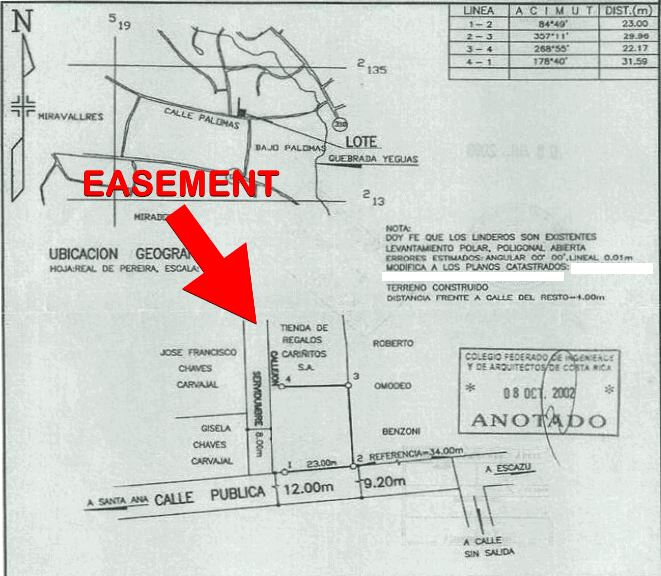An easement — servidumbre in Spanish — is the right to use someone else’s property. If you’re looking to buy property in Costa Rica, you need to know if there are any easements associated with it, and to consider how they will affect the property value.
Difficulties with easements
In one case our office was asked to list a small building lot for sale with a registered easement for a primary power line. The owners had bought the lot without knowing this right of way existed. Nobody had told them about it, not even their own attorney.
All our real estate agents are obliged to run a title check before listing a property, which is how we found out that ICE, the Costa Rican Electricity Institute, had registered the easement but never used it. The easement covered the entire lot, and getting a construction permit would have been impossible. In fact, a luxury condominium – Cerro Alto in Escazú – is right next door and the easement must have run right through that development too.
Long story short, it took us over a year to clear up the title and cancel the easement. Then it took us a week to sell the lot.
When to find out
There are several types of easements, some that are in the property owner’s favor and some that aren’t. There is a good chance you won’t find out about an easement until after you have bought a property. By then, it is too late to do anything about it. Such an easement can definitely affect the value of a property.
How do you know an easement exists?
Easements are registered in the National Registry on the property title, under “gravamenes y afectaciones.” They are also marked on the survey map. When a property is sold or transferred, the easement transfers with the property to the new owner, unless it is canceled before transfer. The original easements of access that belonged to the original property before it was subdivided usually will never disappear from the title.
The description of the easement can be found under “citas” in the title description. This information cannot be found online; you have to go in person to the National Registry to check and identify it. Public easements in Costa Rica, except for the ones constituted by RECOPE, the National Oil Refinery, do not have a time limit — they are “forever.”
Here’s a look at various types of easements.
The right to cross
A servidumbre de paso is the right to cross. When a property is subdivided, it might be necessary to create access to those properties that don’t have public road access. The name used can also be servidumbre agrícola, which is used for larger tracts of land and gives an easement to move cattle from one place to another. This is also used for the roads in low-density agricultural communities. You will find many communities like that in Atenas and coastal areas.
Utilities
Utility companies usually create an easement if they have to go across someone’s property with a power line, a water line or a sewage line (public sewage exists in very few places in Costa Rica).
Some of the major utilities in Costa Rica are ICE (power and phone service), CNFL (power), ESPH (water, power, and sewage), EM Cartago (power, water, sewage and central market), Jasec (power), AyA (water) and RECOPE (petroleum).
A) Water
A servidumbre de agua is the right to take a water pipe across someone else’s property. In some cases, this water easement can be a community’s water holding tank or water well. In some communities, the water pipe for some reason does not run under the road (which could be an exclusive right of way in itself) but runs over all the private properties in the community.

In some communities, rainwater pipes are constituted as an easement. Where there is a public sewer, the sewer pipes will be registered as an easement.
Water irrigation canals in agricultural areas are also registered as a water easement.
B) Power
A servidumbre eléctrica or power easement can be for two things:
• Primary or secondary power lines.
• High-tension primary power lines. All activity is prohibited on easements created for high-tension power lines, such as construction, agriculture or moving earth. Nor can you build fences or walls in or on an easement.
C) Phone
One day we might not need any telephone lines anymore, but until then, a phone line can be an easement. Most phone lines are located inside the power easement and not constituted separately.
View
It is possible for a property owner to register a view easement or servidumbre de vista on the neighboring property, as long as both properties belong to the same owner. For that reason, you will only find properties with a view easement in condominiums and master-planned subdivisions. (Theoretically a really nice neighbor could “give” a view easement to the neighbor behind him, ensuring that he won’t block his view.)
View easements are very difficult to describe. Most attorneys who register a view easement describe it in such a way that the neighbor who could take the view away is allowed only a one-story home, or some other maximum construction height is imposed.
Ecological
I have seen a few ecological easements in communities to protect nature and wildlife. They are constituted so that no one will disturb the nature inside the ecological easement. They are supposedly set up to allow animals to pass through that easement. Rarely do animals pay attention to the law in Costa Rica.
How to cancel an easement
To cancel an easement in the property section of the National Registry, you need the cooperation of the person or public entity in whose favor that privilege of use exists. Cancellation of an easement can be by mutual agreement, expiration of its time limit, or change of the property size by the union of two or more properties.
It’s best to let your attorney handle this. If you try to do it yourself, they’ll send you from one place to the other and back and string you along until you decide to just let it go.
Disclosure?
There is no obligation under Costa Rican law to disclose the existence of an easement. Many real estate agents don’t even know how to run a title check and have no knowledge about easements due to lack of training. A buyer depends entirely on the closing attorney, who might or might not find it necessary to disclose an easement.
Before you make an offer on a property, request a title study from your real estate agent and check for existing easements yourself. Then you can ask your lawyer to check and specify the existing easements before finalizing your offer.
Value calculation
It is quite difficult to calculate the value of an easement. The tax department of the Finance Ministry has elaborated a formula to calculate the damage that is used by ICE, AyA, and court-appointed appraisers.
Property value
Easements rarely affect the property value, but a public utility easement might. Most buyers do not like high-tension power lines, as some think they can affect your health. Some buyers will simply NOT purchase a property that is close to these power lines.
Some easements might constitute a security risk to a property because they allow access to the public road.
Some easements might actually add value to a property, if they create more green space between neighboring properties.
Every case is different, so look before you leap. If you are considering buying property in Costa Rica, find out if any easements exist, understand what they allow, and consider carefully how they will affect the property value. If you have any doubts, consult a lawyer before you purchase.
Ivo Henfling founded the American-European Real Estate Group in 1999 — the first functioning MLS in Costa Rica with affiliate agents from coast to coast. You can read other articles like this on his blog. Contact Ivo at (506) 2289-5125 / 8834-4515 or at ivo@american-european.net.









